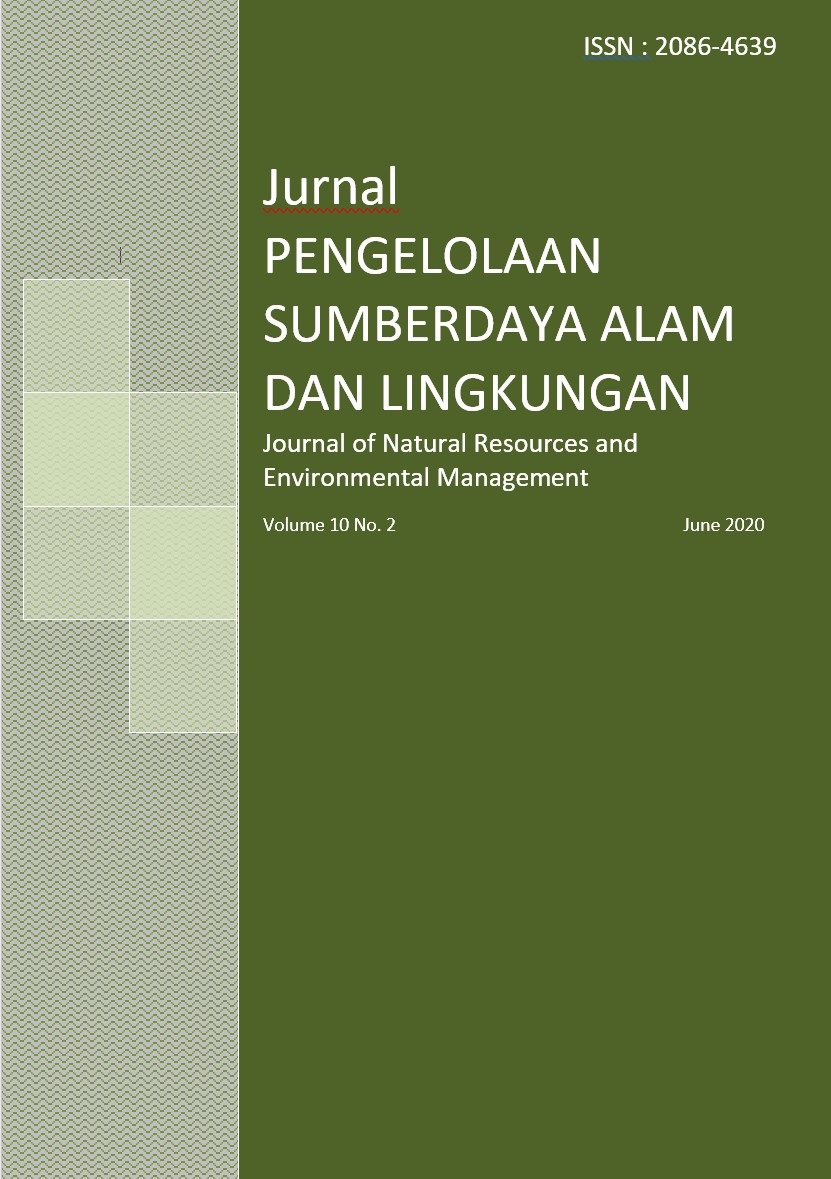The study of mangrove density and shoreline changes from 1989 to 2018 in Jambi Province Coastal Zone
Abstract
The density of mangrove cover is one of the factors that influence changes in shoreline both accretion and abrasion. This study aims to determine the effect of changes in density of mangrove cover on shoreline changes in 1989-2018 in the Coastal Province of Jambi. The method used is the interpretation of Landsat satellite images in 1989, 2000 and 2018 using NDVI (Normalized Difference Vegetation Index) and overlaying images to see shoreline changes and DSAS (Digital Shoreline Analysis System) to calculate the area of change. The results showed that there had been a change in shoreline both accretion and abrasion in several locations that had different mangrove densities in the period 1989-2018. The results showed that accretion occured in 6 locations with an average change of Kota Sebrang 771 m, Tungkal Ilir 240.65 m, Kuala Betara 153.73 m, Mendahara 167.78 m, Kuala Jambi 169.35 m and Nipah 57.3 m, while abrasion occurs at 2 locations with an average change in Sabak Timur -41.8 m and Sadu -36.55 m. Where in the 6 locations that had accretion, mangrove density dominantly was in a close-densed and moderate state and only a few are in a low-densed condition. Meanwhile, the 2 locations that had abrasion were in a moderate state and have a low density mangrove forest.
References
Bengen DG. 2001. Ekosistem Sumberdaya Pesisir dan Laut Serta Pengelolaan Secara Terpadu dan Berkelanjutan. Prosiding Pelatihan Pengelolaan Wilayah Pesisir Terpadu. Pusat Kajian Sumberdaya Pesisir dan Lautan. Institut Pertanian Bogor.
BKSDA (Balai Konservasi Sumber Daya Alam). 2011. Rencana Pengelolaan Cagar Alam Hutan Bakau Pantai Timur Jambi. Jambi.
Departemen Kehutanan. 2005. Pedoman Inventarisasi dan Identifikasi Lahan Kritis Mangrove. Jakarta : Direktorat Jenderal Rehabilitasi Lahan dan Perhutanan Sosial Departemen Kehutanan
Dinas Kelautan dan Perikanan. 2003. Statistik Perikanan Laut. Jambi.
Istiqomah F, B Sasmito, FJ Amarrohman. 2016. Pemantauan Perubahan Garis Pantai Menggunakan Aplikasi Digital Shoreline Anaysis System (DSAS) Studi Kasus : Pesisir Kabupaten Demak. Jurnal Geodesi Universitas Diponegoro. Semarang.
Kasim F. 2012. Pendekatan Beberapa Metode dalam Monitoring Perubahan Garis Pantai Menggunakan Dataset Penginderaan Jauh Landsat dan SIG. Jurnal Ilmiah Agropolitan Volume 5(1).
Kumara MP, LP Jayatissa, KW Krauss, DH Phillips dan M Huxam. 2010. High Mangrove Density Enhances Surface Accretion, Surface Elevation Change, and Tree Survival in Coastal Areas Susceptible to Sea-Level Rise. Oecologia, 164(2): 545-553. DOI : https://doi.org/10.1007/s00442-010-1705-2
Kusmana C. 1997. Ekologi dan Sumber Daya Ekosistem Mangrove. Pelatihan Pengelolaan Hutan Mangrove Lestari Angkatan I. PKSPL dan Dirjen Pemda. Bogor.
Kusmana C. 2009. Pengelolaan sistem mangrove secara terpadu. Workshop Pengelolaan Ekosistem Mangrove di Jawa Barat, Jatinangor 18 Agustus 2009
Kusmana C, Onrizal, Sudarmaji. 2003. Jenis-Jenis Pohon Mangrove di Teluk Bintuni, Papua. Bogor (ID): PT. Bintuni Utama Murni Wood Industry.
Kusmana C. 2015. Integrated Sustainable Mangrove Forest Management. Jurnal Pengelolaan Sumberdaya Alam dan Lingkungan Vol. 5 No. 1 (Juli 2015): 1-6.
Limber PW, JH List, JD Warren. 2007. Investigating Methods of Mean High WaterShoreline Extraction from Lidar Data and the Relationship between Photoderived and Datum-based Shorelines in North Carolina. Tersedia http://ims.ncdenr.org/Website/ncshore/MetaData/2004_Shoreline_Study.pdf
Lubis DP, M Pinem, MAN Simanjuntak. 2017. Analisis Perubahan Garis Pantai Dengan Menggunakan Citra Penginderaan Jauh. Vol 9 (1) :2549–7057
Onrizal. 2008. Panduan Pengenalan dan Analisis Vegetasi Hutan Mangrove.Departemen Kehutanan, Fakultas Pertanian, Universitas Sumatera Utara.
Parman, S. 2010. Deteksi Perubahan Garis Pantai Melalui Citra Penginderaan Jauh Di Pantai Utara Semarang Demak. Vol 7 (1).
Pemerintah Provinsi Jambi. 2014. Laporan Status Lingkungan Hidup Daerah Provinsi Jambi .
Putra H. 2016. Monitoring Sedimentasi Dan Perubahan Garis Pantai Di Estuari Muara Gembong, Bekasi. [Tesis]. Bogor (ID): Fakultas Pascasarjana IPB.
Putra H, Lilik BP, Nyoto S. 2016. Monitoring Perubahan Garis Pantai Dengan Citra Satelit Di Muara Gembong Bekasi. Jurnal Pengelolaan Sumberdaya Alam dan Lingkungan Vol. 6 No. 2 (Desember 2016): 178-186
Rouse JW, RH Haas, JA Schell, DW Deering. 1973. Monitoring vegetation systems in the Great Plains with ERTS. Di dalam : Rouse JW, Haas RH, Schell JA, Deering DW. Third ERTS Symposium; 10-14 Desember 1973; Washington (US): Hlm 309-317
Salim AG, HH Siringoringo dan BH Narendra. 2014. Pengaruh Penutupan Mangrove Terhadap Perubahan Garis Pantai Dan Intrusi Air Laut Di Hilir Das Ciasem Dan Das Cipunegara, Kabupaten Subang. Jurnal Manusia Dan Lingkungan, Vol. 23, No.3, September 2016: 319-326. DOI: https://doi.org/10.22146/jml.18805
Thieler E.R., Himmelstoss, E.A., Zichichi, J.L., and Ergul, Ayhan. 2009. Digital Shoreline Analysis System (DSAS) version 4.0 — An ArcGIS extension for calculating shoreline change. U.S. Geological Survey Open-File Report 2008-1278.
Undang-Undang Republik Indonesia. Nomor 4 Tahun 2011 Tentang Informasi Geospasial.
Winarso G, Judijanto, Budhiman S. 2001. The Potential Application Remote Sensing Data For Coastal Study. Paper Presented at the 22nd Asian Conference on Remote sensing, 5-9. November 2001, Singapore. Center for Remote Imaging, Sensing and Processing (CRISP), National University of Singapore; Singapore Institute of Surveyors and Value (SISV); Asian Association on Remote Sensing (AARS).
Authors
Authors who publish with this journal agree to the following terms:
- Authors retain copyright and grant the journal right of first publication with the work simultaneously licensed under a Creative Commons Attribution License that allows others to share the work with an acknowledgement of the work's authorship and initial publication in this journal.
- Authors are able to enter into separate, additional contractual arrangements for the non-exclusive distribution of the journal's published version of the work (e.g., post it to an institutional repository or publish it in a book), with an acknowledgement of its initial publication in this journal.
- Authors are permitted and encouraged to post their work online (e.g., in institutional repositories or on their website) prior to and during the submission process, as it can lead to productive exchanges, as well as earlier and greater citation of published work (See The Effect of Open Access).
Article Details
10.1080/10106049.2022.2159070
10.30892/gtg.53202-1218






